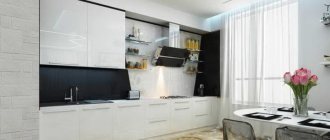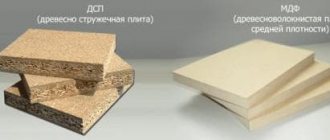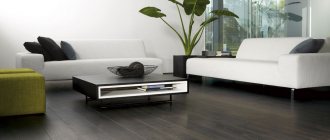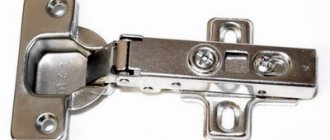Porcelain tile is one of the most successful types of artificial stones; it is made from special components by firing at temperatures up to +1300°C. As a result, the ingredients melt and form a single, very strong structure that has high performance characteristics. At first it was used only for industrial and technical premises, but modern technologies have made it possible to significantly expand the design characteristics; the front surface can resemble natural materials, have different structures and colors, wide roughness values, thickness and linear dimensions.
Porcelain tiles
When choosing a specific brand of flooring material, you need to pay attention to all the characteristics of porcelain stoneware slabs, including their thickness. The larger it is, the higher the resistance to bending loads, including impact loads. But not everything is so simple; this dependence is not direct, but has several factors. The standard thickness of the slabs ranges from 7–12 mm, but for some types of floors thinner or thicker porcelain tiles can be used. The cost of materials also depends on the thickness; this is due to the fact that their production requires an increased amount of raw materials, the firing process is delayed, and this causes excessive energy consumption. What should be the thickness of porcelain stoneware, what are the features of its installation depending on this indicator?
Porcelain stoneware floor
Features of porcelain stoneware
Porcelain stoneware is a unique type of artificial facing stone, which is obtained by pressing certain components and subsequent firing of this mixture at a temperature of about 1300 degrees Celsius.
The tiles obtained in this way have excellent technical characteristics. Initially, this material was used exclusively for covering floors in industrial and technical premises. Modern technologies have made it possible to add aesthetics to the tiles.
What sizes are there?
There are two types of flooring – tiles and porcelain stoneware. The last option is a fairly durable tile, the manufacturing process of which involves pressing under maximum pressure and baking at high temperature. This manufacturing technology allows it to ultimately withstand significant loads.
Due to the fact that the floor is subjected to significant loads, the coating must be durable.
The following standard coating characteristics exist:
- Square shape (200x200, 300x300, 330x330, 350x350, 400x400, 450x450 mm);
- Pentahedron shape (100x200, 150x300, 200x300, 300x400 mm);
- Polyhedron shape (5-sided, 6-sided, 8-sided)
In addition to these parameters, there are other options: smaller and larger.
Ultra-thin porcelain tiles
This type of facing material appeared relatively recently, and not everyone knows about it. The thickness of such tiles is no more than 0.4 centimeters, and the width and length are about 50 centimeters. The advantage of this type is its cost, which is affordable to any buyer. The disadvantage is low strength relative to physical load. Therefore, it is worth using ultra-thin porcelain tiles only in those rooms where the flooring will not be subjected to intense and regular loads. Also, with such a thickness, laying tiles is more difficult than in the case of larger products.
The first rule for laying this type of porcelain tiles is that people without special skills and who are not fully familiar with the coating technology should not be allowed to work.
During the installation process you will need:
- experience working with special tools;
- maximum speed;
- care, but at the same time accuracy and precision of every movement.
The most difficult step is laying the tiles on the prepared base with glue applied to it. The product must be held with vacuum suction cups, and then it must be laid perfectly evenly on the glue, joining the existing tiles without corners or gaps. Laying can only be done on a perfectly flat floor. It will not be possible to level the subfloor using an adhesive base, which means you will need an additional screed. According to the standard, ultra-thin porcelain tiles are not used in such conditions, but are used only when necessary to replace existing ceramic coatings. The tiles can be laid over the old ones, which will significantly reduce the cost of time and money.
Also, porcelain tiles must be periodically trimmed during installation. A symmetrical coating can only be obtained in this way. However, this procedure also requires considerable experience and knowledge of cutting technology.
The tiles are so strong that the slightest mistake can cause cracks to form. The tool must be in perfect condition so that minimal vibrations of the grinding machine disk do not create defective edges on the tile.
Experts say that the most effective for this process would be to use a diamond-coated disk with a water cooling system. The tile that needs to be cut should be laid on a much larger piece of polystyrene foam so that the base is level and motionless.
The adhesive must be applied to the base in such a way that the thickness of the material is equal over the entire coating area. If a standard thickness of floor tiles is used, porcelain tiles can be laid using a rubber hammer, but as for ultra-thin products, they may not withstand the impact force of this tool. The most important condition during installation is the absence of air-filled voids between the tiles and the base. If these are present, the already low strength of porcelain tiles will be significantly reduced.
Laying a single product must be done the first time, since the adhesive mixture quickly pulls it to the surface, and the large area of the tile, combined with low strength, does not allow it to be pryed off with any tool.
In this regard, the popularity of ultra-thin porcelain stoneware slabs is very low and they are used in rare cases. Only those specialists who have sufficient skills and experience in working with such material can be allowed to lay ultra-thin porcelain tiles. Ultra-thin porcelain tiles also have not found popularity among sellers due to low strength and high risk of damage during transportation.
How to lay and choose different sizes of porcelain tiles: secrets of the masters
Let's talk about installing porcelain tiles. After all, how long it will last depends on how it is installed. Tips and life hacks from the company’s pros for you:
- The main problem with large format porcelain tiles is their delivery and installation. The first is solved through proper packaging, as well as responsible workers. Secondly, choosing a reliable glue manufacturer.
- Laying a large-format ceramic coating takes about the same time, but requires more skill - in order not to damage the material in the process, you need to fix it with maximum reliability.
- To finish facades, tiles are fixed not only with glue, but also with special fasteners. Consequently, the thickness of the material cannot be less than 8-10 mm, since laying ultra-thin coatings and even just thin ones is impossible.
- Floor coverings are the easiest to install, and the choice of material depends on the load. For a house, a thickness of 8 mm will be enough. For an office - no less than 10 mm, and for warehouses - no less than 12 mm.
- If it doesn’t matter to you which material to choose, choose matte models of medium sizes 30x30 or 60x60 format. It can withstand the load perfectly, costs less, and is as simple as possible to install and maintain.
The choice of finishing materials is only the beginning of the journey. You have to understand many details and take each of them into account in order to correctly calculate all the work...
Porcelain tiles with standard thickness
As already mentioned, a thickness of 0.7-1.2 centimeters is typical for standard porcelain tiles. This type is the most popular among builders, because... its technical characteristics are optimal. With the help of such slabs, floors are covered both in residential buildings and in facilities where there is a constant flow of people, and, accordingly, a large load on the coating. The linear dimensions of the slabs can vary in the range from 5x5 to 60x60 centimeters.
The use of this facing material is described by state regulations, which contain information about the permissible load on the coating.
The standard thickness of porcelain tiles for flooring allows you to create additional types of tiles:
- technical - have the lowest cost and are used to create floor coverings in industrial workshops and warehouses. The tile received this name due to the lack of additional surface treatment. The advantage of the material is that it does not react to the influence of an aggressive environment, and the rough surface without treatment eliminates the sliding effect, increasing the safety of the work process;
- glazed - this is the most expensive type of material, which contains an additional layer of substance that allows, after firing, to give the material a different surface color. This type is most often used in residential buildings or luxury establishments, where the aesthetic beauty of the flooring is very important;
- matte - after the firing stage, the front surface of the porcelain tile is ground with a coarse-grained wheel. As a result, the tiles do not slip and look very presentable in appearance, which allows you to take a pre-sale photo of the floors in the house or show them to guests. The cost of this material is low;
- polished - externally they are the height of perfection, and in cost they exceed all other varieties. The disadvantage of a polished surface is that it cannot be used in open areas (balconies, terraces, verandas, etc.), since exposure to natural precipitation causes destructive processes on the front side;
- structured - their thickness should not be less than 1 centimeter, since a smaller value will also affect the strength characteristics of the product. Such requirements arise due to the relief of structured tiles. In places where there are depressions, its thickness will be critical, and the increased load will cause deformation. The advantage of this type is that the front surface can be an imitation of parquet, fabric, leather, etc. In special cases it is processed by etching or applying a layer of gold leaf.
The technical characteristics of this type of porcelain stoneware slabs allow them to be used anywhere. Experts believe that such material is the most reliable, effective and cost-effective.
Dimensions of wall tiles
When installing vinyl wall tiles, the use of connector moldings is not required. In addition, thanks to the laying of such facing material, easy access to technical communications is maintained. The surface of the material is non-slip compared to ceramic.
Among the advantages of PVC panels and slabs are noted:
- moisture resistance;
- when laid correctly on the walls, it is visually difficult to distinguish from ceramic;
- cheap material;
- can be marble, wood or stone in color;
- PVC is an environmentally friendly material;
- The laid white PVC tiles on the ceiling look good and do not allow moisture to pass through.
PVC ceiling, wall or floor tiles must be laid on the sheathing. In the bathroom, each wall will become smaller by approximately 4 cm. This should be taken into account by owners of small bathrooms.
Tiles 15 x 15 cm - the best choice for the bathroom
The standard for wall cladding is ceramic products. You can use mosaics, small tiles from 2.5x2.5 cm, 33x33 cm and larger. For a large bathroom you can choose absolutely any tile, but for a small one it is better to use a small one.
It is worth noting that ceramic products are the standard for finishing walls, floors and ceilings. Most often, white or any light color is laid on the ceiling and walls, and dark on the floor. You can decorate the wall with slabs with a pattern or pattern. Finishing material of marble, wood or stone color can be laid on the floor and walls; these slabs imitate the texture of natural materials. Only, unlike a marble slab, a ceramic one is lighter and cheaper.
Tiles 10 x 10 different colors
Tiles with dimensions of 15x25 cm, 20x25 cm are suitable for small bathrooms. Khrushchev's houses usually have small bathrooms. Floor tiles can be larger in size, however, it is better to choose them in proportion to the wall tiles.
For larger bathrooms, ceramic finishing materials measuring 33x45 or 30x60 cm are used. These are the most common dimensions of ceramic slabs.
Thick porcelain tiles
This type of material corresponds to the greatest thickness of floor porcelain tiles, which reaches a value of more than 2 centimeters. The length and width in this case can vary at the request of the manufacturer or customer. For example, porcelain tiles for a garage floor will be thick enough to withstand increased loads.
Such plates have some installation features:
- the large mass of one product requires great physical strength for installation, and it is most reliable to use mechanical lifts;
- Thick porcelain stoneware slabs are laid without the use of an adhesive mixture, since the weight of the product creates a strong adhesion to the base.
The area on which the installation will be carried out must be leveled. To do this, it is covered with sand and compacted using special vibration machines. After this, the sand layer is checked again to identify any remaining irregularities and, if there are none, the laying process begins.
To achieve maximum strength of the base, sand is sprinkled with cement in the proportion of one bag per 10 square meters. This mixture will begin to interact some time after laying the slabs, and the strength of the base will increase significantly.
The installation process is standard procedure. To ensure that each tile is laid perfectly evenly, use a stretched rope. You can adjust the laid tiles using the same much larger rubber hammer or another device with high impact force.
You can also add sand mixture under the tiles. Cutting thick porcelain stoneware slabs is only possible when using powerful units, since an ordinary grinder will take a very long time to cope with the task, and correcting unevenness will make you suffer again. To check the angle of inclination of the porcelain stoneware covering, you must use a long building level or ordinary wooden slats.
A mixture of sand and cement is poured on top of the already finished coating, and then swept over the entire area with an ordinary broom. This composition will reliably fill all the joints between the slabs. The last step should be to add liquid to this mixture, which will cause it to harden and make the coating perfectly smooth. Intensive loads should not be allowed on porcelain stoneware slabs for two weeks after installation, since this is precisely the time interval required for the cement mixture to harden.
Today, thick porcelain stoneware slabs are most often used to create durable areas for parking lots, paths in parks, etc.
Important nuance
It is worth considering that the dimensions of ceramic tiles are imprecise. This means that the actual size of each element may deviate slightly from the declared size. And this is not due to defects or negligence of the manufacturer, but to ceramic production technology. The firing behavior of different types and even batches of clay may differ, so it is impossible to accurately maintain the specified parameters of the tile. Large manufacturers try to form batches in such a way that the sizes of the tiles in them are as close to each other as possible. However, experienced craftsmen say that ceramics, all of whose elements exactly match in size, are quite rare.
To compensate for these deviations, when laying tiles, seams are provided that are filled with a special compound - grout. Therefore, when the coating is laid and the tile seams are rubbed, the difference in the sizes of the tile elements becomes unnoticeable. By the way, sometimes manufacturers indicate the dimensions of tiles taking into account the recommended joint thickness. This means that with the stated parameters of 33x33 cm, the tile can actually have a size of 32.8x32.8 cm.
Tips for choosing thickness
After reading this article and familiarizing yourself with all the operating conditions for each type of porcelain tile, you should not immediately rush to the market for thick porcelain tile. It is necessary to understand that airy voids, even under this type, will cause the structure to split under slight physical stress. Therefore, the main task of the buyer is to take care of both choosing tiles of suitable thickness and finding a specialist who will carry out the installation.
You can check the quality of tile laying both during self-installation and if the work is carried out by hired workers. It is enough just to tap the surface to understand where the voids are hidden under it, if there are any. Such places will respond with a ringing sound when you hit the tile.
When purchasing, you need to check the materials to understand how high quality they are. Linear dimensions can be checked with measuring instruments. To find out how smooth the surface is, you just need to stack one tile from two packages together and check that there are no gaps between them, as well as the perfect coincidence of the perimeters will indicate the high quality of the products.
Bottom line
From all of the above, it can be understood that when choosing porcelain tiles, you must first of all rely on the technical characteristics of the product. Cost is not the main indicator, since the owner who wants to save money will make a terrible mistake. Insufficient strength of the tiles will lead to their destruction, and the excess weight of thick porcelain stoneware can negatively affect the base, and much more money will have to be allocated for the purchase of material.
Accordingly, the most effective solution would be to seek help from a specialist who will take the necessary measurements, select the type of porcelain tiles and complete the installation in the shortest possible time.
Size range
Due to its high density, porcelain stoneware is characterized by fragility. This is one of the main reasons that justifies the technical restrictions on the physical parameters of the tile. The second point is weight. To avoid “fragility” of dimensional samples, the thickness of the products is increased. But this significantly affects the final mass of both a single specimen and the entire cladding. It is important that the load on the supporting base and foundation is not critical.
Factory calibration
By caliber here we mean an error regarding the size of porcelain tiles, for example, for a floor, against the background declared by the manufacturer. It is almost impossible to achieve perfect similarity of workpieces, since the output products turn out different at the slightest violation of the proportions of one or another component. That is, it is impossible to completely exclude such a result in practice.
Cutting porcelain tiles on a production line Source elitkras.ru
It is necessary to consider the geometry of the tile to obtain a high-quality facing coating. Between individual finishing elements, a seam within 5 mm is often maintained. The error may be 0.1-0.7%. That is, if a sample size of porcelain tile for the floor has a side of 400 mm, then the deviation from the specified parameter can reach 2.8 mm. With such a discrepancy, the seams formed will be noticeably different.
When choosing tiles, you should pay attention to the caliber of the products. For example, regarding the dimensions of porcelain stoneware 300*300 mm, samples with an error of up to 0.5 mm will be considered zero, samples with an error of up to 0.5 mm will be considered zero, samples with an error of up to 1.5 mm will be considered the first, and samples with an error of 2.5 mm will be considered the second. That is, for finishing one area, it is worth considering collections from an identical batch, which is sorted in the factory.
A clear example of tiles with deviations from the specified size Source postach.com.ua
Standardized parameters
According to GOST R 57141 of 2016, the limit values for porcelain tiles are limited to 200*300-1200*1200 mm, the thickness of porcelain tiles for the floor should not be less than 7 mm. In this case, the second parameter is determined at the discretion of the manufacturer. The plant can also provide services for the production of tiles according to individual parameters (shape, height, color, surface). Let's take a closer look at the thickness and sides of porcelain stoneware, which are often used depending on the shape.
Square samples
Samples with equal sides are the most popular option in the construction market. This makes it easier to choose a layout, and there is less trimming and waste. Craftsmen note that with square tiles it is easier and faster to complete installation work, and samples are less likely to split when adjusting their position on the base.
Bursting tiles due to violation of laying technology Source expert.agromat.ua
For flooring, porcelain stoneware of this shape is most often used with sides from 100 to 600 mm in increments of 50 or 100 mm. Due to the peculiarities of factory equipment, some manufacturers produce tiles with a width of, for example, 165, 320, 333, 410, 420 mm. When choosing cladding from such collections, it is important to pay attention to the possibility of purchasing artificial stone with similar dimensions and caliber, if such a need arises. Difficulties often arise with this event.
Alignment methods
When working with porcelain stoneware, use a holder with suction cups. As a result, you will be able to lift heavy tiles when they are piled up.
Often the tiles clearly float on the adhesive, pressing it down, especially if there are differences in plane on the floor. Uneven shrinkage occurs. If the glue is made thicker, it will begin to lag behind the porcelain tiles, so you should use other methods.
When laying heavy porcelain tiles with joints, tile leveling systems should be used. Few piece systems are needed, since the products are usually large in size. Thanks to the SVP, you will ensure an absolutely flat floor surface.
Seamless installation requires a different method. Under the corners of the tiles, 4 screws in plastic plugs should be driven into the floor. Adjust their height by scrolling before applying the adhesive, aligning the tiles in the plane of the floor. This will allow you to lay heavy porcelain tiles evenly, although it will require considerable effort.
Porcelain tiles do not have edging or distorted geometry, so precautions must be taken. An insufficiently responsible approach to work will lead to the fact that even small flaws will completely ruin the floor covering.
What are crosses and why are they needed?
Most of them, of course, use tile crosses, since this is a more economical method, especially for DIY installation rather than professional installation.
The crosses themselves are small plastic devices that help to efficiently carry out such a creative process - laying tiles.
Yes, this process is truly creative, since it involves transforming a gray concrete floor (not necessarily concrete, it can also be wooden or already covered with tiles; see how to lay tiles on tiles in a separate article) practically into a work of art. And the seam created by the floor tiles helps make the surface really shiny (and we’re not talking about its shine, but about its beauty). It is thanks to them that the colors of the tiles shimmer successfully, complementing the surrounding atmosphere.











